HomeHip/Leg
Hip/Leg
Conditions
Hip / Leg
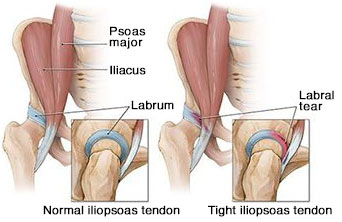
Iliopsoas Tendonitis
Tendonitis is most often due to overuse of muscles. Although cyclists, long-distance runners, and triathletes are susceptible to these soft tissue injuries due to the volume of exercise they engage in. The muscle this is a condition more often seen in the nonathletic population. The major players in the hip flexor muscle group are the psoas major muscle — which is attached to the lumbar spine and the pelvis — the smaller psoas minor muscle, and the iliacus muscle. It is the large psoas muscle that is most susceptible to a hip flexor injury, and it is also the tendons associated with this muscle where tendonitis affecting the hip flexor is most likely to be centered.
Our hip flexor muscle group goes from our lumbar spine at a 45-degree angle to attach into the inner portion of our hip. Prolonged sitting or standing can increase the risk of having these issues.
Common symptoms include:
· Hip pain that progressively worsens with activity
· Clicking or popping in hip or groin region
· Hip pain when sitting or rising from a seated position
· Pain that refers to the lower back, groin, or leg regions

Sciatica
Sciatica refers to pain that radiates along the path of the sciatic nerve. The sciatic nerve is the longest nerve in the body. It passes alongside or goes through the piriformis muscle, goes down the back of the leg, and eventually branches off into smaller nerves that end in the feet. Nerve compression can be caused by spasm of the piriformis muscle, herniated disk or bone spur on the spine from degenerative changes. This causes inflammation, pain, and often numbness in the affected leg. Typically, sciatica affects only one side of your body.
The pain is commonly due to the piriformis muscle that is tight and compresses the sciatic nerve, such as while sitting in a chair at a desk, sitting in a car seat, or with running — especially uphill. Pain may also be triggered while climbing stairs, applying firm pressure directly over the piriformis muscle, or sitting for long periods of time.
Common Sciatica symptoms include:
· A dull ache in the buttock
· Piriformis entrapment syndrome
· Lumbar disc herniations
· Pain down the back of the glut, thigh, calf, or foot
· Pain when walking upstairs or inclines
· Increased pain after prolonged sitting

SJ Joint Pain
Sacroiliitis causes SI joint pain and is an inflammation of one or both of your sacroiliac joints. This is where your lower spine and pelvis meet. Sacroiliitis can cause pain in your buttocks or lower back and may even extend down one or both legs. The pain associated with sacroiliitis is often aggravated by prolonged standing or by stair climbing. Sacroiliitis can be difficult to diagnose, because it may be mistaken for other causes of low back pain. Sacroiliitis may be felt as a deep pain in the back or buttocks that typically gets better with activity. It generally is worst at night or in the early morning.
Symptoms often aggravated with:
· Prolonged standing
· Bearing more weight on one leg than the other
· Stair climbing
· Running
· Taking large strides
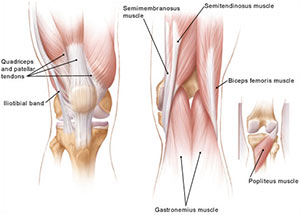
Hamstring / Quad Injuries
The hamstring and quadriceps muscle groups are particularly at risk for muscle strains because they cross both the hip and knee joints. Hamstring and quadriceps injuries frequently occur near the point where the muscle joins the tough, fibrous, connective tissue of the tendon. A similar injury occurs if there is a direct blow to the muscle.
Once a muscle strain occurs, the muscle is vulnerable to re-injury. It is important to let the muscle heal properly and to follow preventive guidelines from your doctor.
A hamstring injury occurs when you strain or pull one of your hamstring muscles. The hamstrings are a group of three muscles that run along the back of your thigh. Most notorious hamstring that gets injuries is bicep femoris. You may be more likely to injury this hamstring if you play a sport that involves sprinting with sudden stops and starts. Hamstring injuries typically are very limiting and can present with black and blue bruising if tears occur. In some cases, there has been lumbar disk herniation associated with hamstring and quad injuries.
At EnovAte SportsMed, we go to the length of proper diagnosis, evaluation, and imaging to get an accurate visual of what is going on. We pride ourselves in not missing steps and taking proper approach to everyone’s condition or problem.
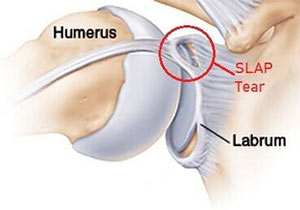
Labrum Tears
A hip labral tear involves the ring of cartilage, called the labrum, that follows the outside rim of the socket of your hip joint. The labrum acts like a rubber seal or gasket to help hold the ball at the top of your thighbone securely within your hip socket. Active adults between the ages of 20 and 40 are affected most often by this injury, requiring some type of treatment in order to stay active and functional. New information from ongoing studies is changing the way this condition is treated from a surgical approach to a more conservative (non-operative) path.
It was once believed that a single injury was the main reason labral tears occurred (running, twisting, slipping). Improved radiographic imaging and anatomy studies now make it clear that abnormal shape and structure of the acetabulum, labrum, and/or femoral head can also lead to the problem. Injury is still a major cause for labral tears. Anatomical changes that contribute to labral tears combined with repetitive small injuries lead to a gradual onset of the problem. Athletic activities that require repetitive pivoting motions or repeated hip flexion cause these types of small injuries.
Symptoms may include:
· Sharp pain around hip or groin region
· Increase in pain with hip rotation
· A feeling of your hip catching or clicking
· Pain with getting in and out of the car
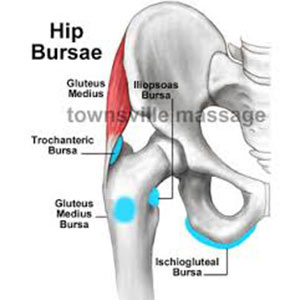
Hip Bursitis
Hit bursitis is an inflammatory condition that affects the synovial joints. Repetitive mirco trauma that cause irritation to the bursa. Bursae are small, jelly-like sacs that are located throughout the body, including around the shoulder, elbow, hip, knee, and heel. They contain a small amount of fluid and are positioned between bones and soft tissues, acting as cushions to help reduce friction.
By far, the most common type of hip bursitis is from the trochanteric bursa. This can be injured in one of two ways: through a direct impact to the bursa, such as a fall onto the outer hip, which is known as traumatic bursitis, or through repetitive friction from the overlying muscles and tendons, usually during running. This repeated friction results in the bursa becoming inflamed and swollen.
Trochanteric bursa – outside of the hip between the greater trochanter and gluteal muscles
Gluteus medius bursa – between the gluteus medius muscle and the greater trochanter
Iliopsoas bursa – between the iliopsoas muscle at the front hip joint and the underlying bone
Ischial bursa – between the hamstring tendons and the base of the pelvis
Other causes that should be considered when assessing this particular area are infections such as osteomyelitis and cellulitis should be ruled out. Other known cause of inflamed bursae are as listed.
· Muscle tears
· Falling on a hard surface
· Friction of muscles
· Associated chronic low back
· Postural abnormalities
· Osteoarthritis of the hip
· Osteoarthritis of the knee
· Previous hip fracture repair
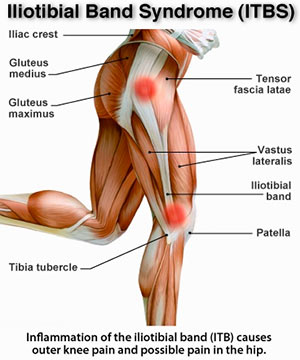
ITB Syndrome
Iliotibial Band Syndrome (ITBS) typically presents itself with knee pain on the lateral, or outside edge, of your knee at the lateral epicondyle of the femur. It occurs when the iliotibial band, the tendon that runs down the outside of the thigh from the hip to the knee, becomes tight or inflamed. When the IT band becomes stretched and tight, it causes friction along the quad or hamstring muscles.
ITB syndrome typically is due to tightness in the hips or lack of hip flexibility. Pain may occur while running downhill or may even be absent while running uphill. It can even be painful enough to drastically limit or even completely stop training. Iliotibial band syndrome (ITBS) is one of the most common sources for knee pain. It is estimated that 60% of all runners are injured in an average year. About one-third of those injuries occur to the knee, producing a yearly incidence rate of one in five runners.
Common signs & symptoms include:
· Stabbing pain along the outside of the knee
· A feeling of the ITB “snapping” over the knee with motion
· Swelling near the outside of your knee
· Tightness or pain at the outside of the hip
· Pain with walking, climbing, or descending stairs
